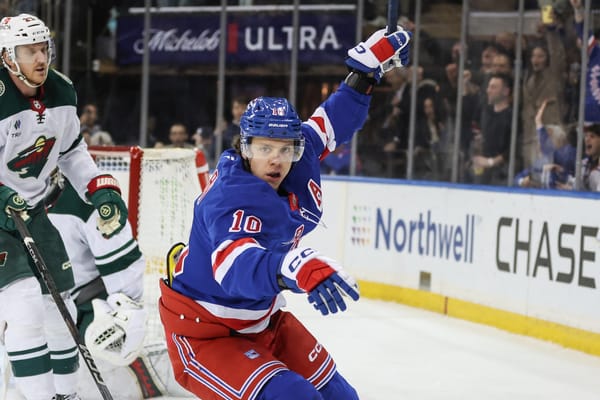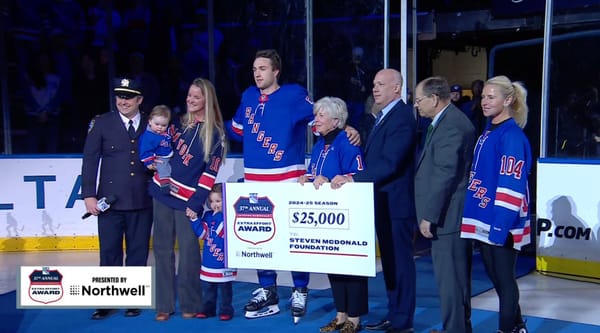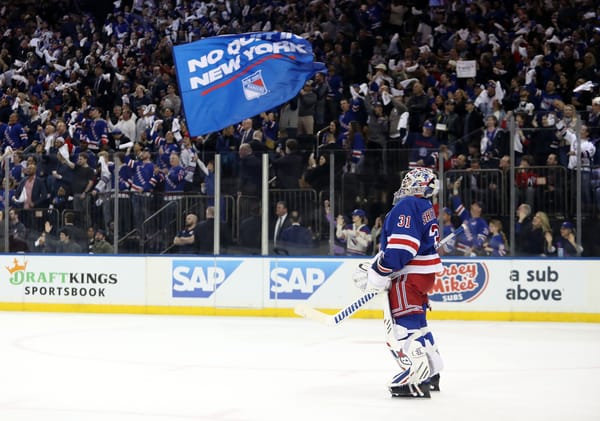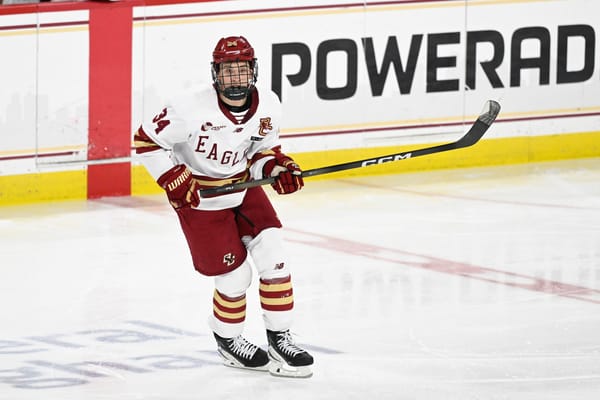Mumpless Dan Boyle Practices With Team - The State of The Rangers Defense Corps
Dan Boyle should be back for Saturday's game at Detroit, making the roster whole again (absent Tanner Glass but...). What should we expect from the beleaguered Rangers defense corps moving forward? Hopefully, a clean bill of health and sustained presence in the lineup, at least.
I would really like for the Rangers defense to be whole again. And to be that way for a sustained stretch of time. Because it has been really difficult to assess how they will perform as a full unit when Dan Boyle and Ryan McDonagh, arguably (actually, definitely) their two top defensemen, have been in and out of the lineup and knocking off rust in between.
Boyle, who does not have the mumps, seems to be recovering from his flu symptoms. He is practicing with the team as of Thursday morning, and I would imagine will be on track to play this Saturday when the New York Rangers visit the Detroit Red Wings.
Dan Boyle is back on ice practicing with the #NYR this morning after missing 2 games with the flu...Tanner Glass (mumps) not practicing
— New York Rangers (@NYRangers) December 4, 2014
This is significant news, as the Rangers have struggled without his services on the powerplay, going just 16% without him, and 20% with him in the brief time he has been available after his finger injury caused him to miss all of October and then som. Now I know that a 4% difference doesn't sound like much. But over the course of a season, it would be a significant increase, were it to continue. That doesn't account for rust either. The improvement in proficient puck movement has been very noticeable, and it would be fair to expect that the Rangers will score more with the powerplay specialist quarterbacking the unit, than it would without.
Having a healthy and high performing Dan Boyle and Ryan McDonagh is critical for what has proven to be a very shaky defense. We know that much. Neither has really had an opportunity to hit their stride and perform at a level that they would be expected to, or at least have traditionally been capable of.
The question then is whether Alain Vigneault will optimally deploy what he has to maximize each player's beneficial skill-set. I am not convinced that has happened to date. Though, to be fair, he has not been working with a full deck.
In the brief time since McDonagh's return, the pairings have looked something like the below, albeit with in-game situational tinkering. This could change, but it is what I anticipate going forward.
McDonagh-Girardi
Staal-Boyle
Hunwick/Moore-Klein
Unit Performance:
Glossary (note - all stats are at 5v5 even strength):
CorsiFor60 = number of on-ice shot attempts for NYR per 60 min of TOI (higher is better)
CorsiAgn60 = number of on-ice shot attempts against NYR per 60 min of TOI (lower is better)
TeamShotFor% = percentage of on-ice shots for/against NYR (higher is better)
TeamGoalFor% = percentage of on-ice goals scored for/against NYR (higher is better)
TOI% = percentage of team total TOI per game (higher is more)
TOI Competition % = quality of competition as measured by the competition's average TOI (higher is tougher comp)
The graphs below set aside defensive zone starts, which should be a known variable that could have impact on some of these rates. I tend to minimize their impact as they truly only measure where players start after a stoppage. I look more closely at the TOI quality of competition they face in terms of usage. But I would be remiss to not at least note the above variable.
Even with Ryan McDonagh's relatively poor play to date, by his standards, he represents an improvement in every category over Dan Girardi's numbers this season. This is also revealed in their With or Without Yous (WoWYs) as well. Much like last season, in the 119 minutes of 5v5 time Girardi has been able to play with McDonagh, Girardi's Corsi For % (CF%) shoots up from 44.4% without McDonagh, to 50.9% with him.
McDonagh has only played 89 minutes apart from Girardi and has maintained a 49% CF% in those situations. This suggests he is basically carrying Girardi, despite his own struggles to date. By contrast, when Girardi was paired with Marc Staal, he dragged Staal's CF% from 50.6% all the way down to 45.7% over the 185 minutes they have played together. That is not a duo that has performed well under the weight of time absent Mcdonagh or Boyle.
Traditionally, McDonagh has carried this pairing to a drastic degree, as last season showed (57.1% apart from G, 50% together). Is this optimal? I don't like the idea of my top pairing having an anchor system in place, given the TOI% they are likely to take. And that is why I hate that Girardi extension so very much.
Same deal. When Boyle is on the ice, the Rangers suppress shot attempts better, while generating more shot attempts. The Team Goal % goes up as well.
Now, as indicated above, Staal's season has been seriously dragged down by playing with Girardi and getting a heavy dose of tougher competition and much greater defensive zone starts to date than Boyle has had in his small sample size of play. As this unit evens out, I would anticipate they will get fairly similar deployment to the top unit, albeit with likely a tick less 5v5 TOI, situationally (simply because McDonagh is going to be the preferred performer in close and late even strength situations.
My issue is that in their brief time together, Boyle and Staal haven't exactly set the world on fire. Boyle only has ~70 minutes of time apart from Staal, so hedge this with a neon flashing small sample size alert sign; but in that short time, he is pushing a 54.3% CF%. That time has mostly been spent with John Moore. Boyle's CF% without Staal is higher than the Boyle-Staal pairing's 49.4% when on the ice together (~47 min).
Again, and I can't say it enough, small sample sizes. But noteworthy nonetheless.
The third pair doesn't seem that controversial to me, on the surface. Kevin Klein and Matt Hunwick have consistently performed as the best versions of themselves. Moore has been very "big mistake" prone, and just hasn't done enough in any one part of his game to warrant consideration to start over Hunwick on a regular basis. But it is worth noting that when Hunwick has played with more (~76 min), they've performed out of their shoes under a bit of sheltering.
Hunwick apart from Moore: 50.9% CF%
Moore apart from Hunwick: 47.6%
Hunwick-Moore together: 58.8%
Maybe there is something to that pairing, and it certainly warrants deeper analysis as to specifics in play style and deployment that might have lead to those kinds of numbers. If it is something sustainable...does that make Klein and his relatively chunky $2.9m AAV cap hit expendable? For salary cap considerations, maybe you poke around and see if there is any interest in a guy who is scoring at a much higher clip than he ever has before.
So let's take a look at all the D to date:
I highlighted the two thorns in the bramble that snagged me. As it stands, two of the defensive "stalwarts" on this team are Marc Staal and Dan Girardi. Neither of them performs like it. We can continue making excuses: tougher competition, more defensive zone starts, tons of TOI when Boyle and McDonagh were out...whatever. They just don't do well. Every positive rate you want goes down. CA60 goes up. Once again, these are anchor types. They aren't driving play. And it shows.
So What's Next?
Well, hopefully a prolonged stretch of 7 healthy defensemen. Namely Dan Boyle and Ryan McDonagh.
Hopefully those two in particular help carry the load, minimizing the negative impact of Girardi and Staal, who will continue to get heavy usage. If those two pairings can find some chemistry, be it Girardi and Staal freeing up the two more mobile skaters to roam and stretch the ice with their passing, or winning DZ 50/50 pucks to feed off to their more able puck-movers for cleaner zone exits, the Rangers will at least begin to resemble last year's team. If they can't, or Boyle and McDonagh underperform, or they get hit with more injuries...this all won't end well.
It may end in a mid-season trade or two.
Stats compiled from: war-on-ice.com and stats.hockeyanalysis.com




